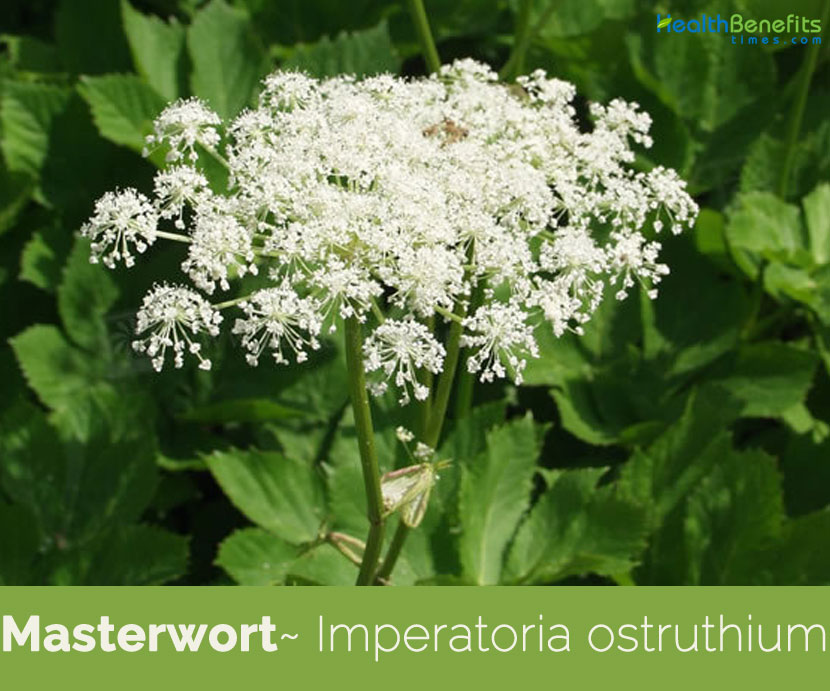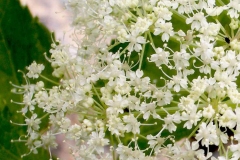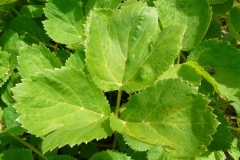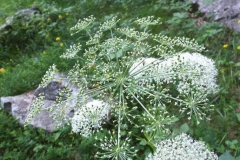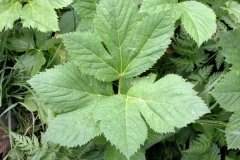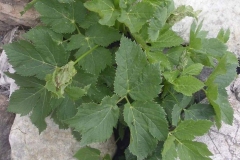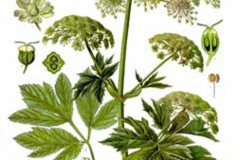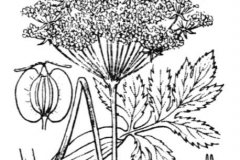| Masterwort Quick Facts | |
|---|---|
| Name: | Masterwort |
| Scientific Name: | Imperatoria ostruthium |
| Origin | Mountains of Central and Southern Europe |
| Colors | Yellowish brown |
| Shapes | Round fruit with broad, pale yellow winged edge |
| Taste | Pungent |
| Health benefits | Beneficial for asthma, fevers, colds, colic, spasms, water retention, palsy, dropsy, gastrointestinal tract, epilepsy, flu, colds, cardiovascular system, apoplexy and menstrual conditions |
| Name | Masterwort |
|---|---|
| Scientific Name | Imperatoria ostruthium |
| Native | Mountains of Central and Southern Europe, including the Carpathians, Alps, northern Apennines, Massif Central and isolated occurrences in the Iberian Peninsula |
| Common Names | Masterwort, Imperatoria, hogfennel , Madnep, Cow Cabbage, Imperatoria, Cow parsnip, Youthwort, Hogweed, Madnep, Heracleum lanatum, Heracleum maximum and also Wooly parsnip |
| Name in Other Languages | Catalan: Imperatorial, salsufragi Croatian: Boskva Czech: Všedobr horský, Všeliek hojivý, smldník všedobr, Danish: Almindelig Grådodder, Hvid Kalkkarse, mesterrod Dutch: Meesterwortel English: Masterwort, Imperatoria, hogfennel Esperanto: Pufa peŭcedano Finnish: Hietakilpiruoho, Kaukasianpitkäpalko, Rohtosuoputki French: Impératoire, Peucédan impératoire, Peucédan ostruthium, autruche, benjoin, benjoin français, impératoire officinale, ostruche, German: Meisterwurz, Kaiserwurz , Astrang, echte Meisterwurz, Magistranz, Ostruz Hungarian: Mestergyökér Italian: Erba renna, Elafobosco, Imperatoria vera, elafobosco erba renna, imperatoria vera, elafobosco, imperatorial, imperatoria commune Latvian: Meistarsakne Nederlands: Meesterwortel Norwegian: Grådodre, Hageskrinneblom, Meisterrot Persian: پوسدانوم استراثیوم Polish: Gorysz miarz Portuguese: Imperatória Russian: Gorichnik nasturtsiyevyy (Горичник настурциевый) Slovak: Všeliek hojivý Slovene: Jaščarica silj Spanish: Imperatorial, Imperatoria romana, servato Swedish: Fagertrav, Gotlandstrav, Grustrav, Grådådra, Mästerrot Welsh: Ffenigl-y-moch gwridog |
| Plant Growth Habit | Clump-forming or slowly stoloniferous perennial herb |
| Growing Climates | Woodland, damp fields, river banks and mountain meadows |
| Soil | Grow best in a rich, organic woodland soil |
| Plant Size | 2 to 3 feet tall when in flower, but only half that when in leaf |
| Leaf | Leaves are rich green with a palmate arrangement and five prominent lobes, each of which is cut or incised terminally |
| Flowering season | June to August |
| Flower | Flower heads are 1 to 1 ½ inch wide and produced in considerable numbers. Bloom color of the species is white, but in most of the clones now being marketed the flowers are pink, maroon or red |
| Fruit Shape & Size | Round fruit with broad, pale yellow winged edge |
| Fruit Color | Yellowish brown |
| Flavor/Aroma | Strong celery-like smell |
| Taste | Pungent |
| Plant Parts Used | Root, seeds |
| Available Forms | Tea, liqueurs, wine, fumigation, tincture or incense |
Plant Description
Masterwort, a common name shared by at least two members of the carrot family, is a clump-forming or slowly stoloniferous perennial herb that normally grows about 2 to 3 feet tall when in flower, but only half that when in leaf with a knobby rhizome (sometimes with runners) containing a milky sap. The plant is found growing in woodland, damp fields, river banks and mountain meadows. It grows best in a rich, organic woodland soil. Leaves are rich green with a palmate arrangement and five prominent lobes, each of which is cut or incised terminally.
Flower & Fruits
Flowers emerge in late spring on upright, branched panicles and appear sporadically through the summer. The flowers are technically an umbel but very different than Queen Anne’s lace and other members of the parsley family, because in Astrantia each bloom is subtended by a broad, papery bract giving the bloom heads an almost daisy-like look. Flower heads are 1 to 1 ½ inch wide and produced in considerable numbers. Bloom color of the species is white, but in most of the clones now being marketed the flowers are pink, maroon or red. Flowering normally takes place in between June to August.
The flowers of masterwort are good for fresh or dried arrangements. They are grown commercially as cut flowers, making a good, long-lasting bloom because the papery bracts persist longer than the petals of many blossoms. They are recommended for use as a stream side planting, or as an informal ground cover in open woodlands or in the mixed perennial border.
Fertile flowers are followed by round fruit that are yellowish brown with broad, pale yellow winged edge.
Traditional uses and benefits of Masterwort
- Masterwort is used to treat gas problems, asthma, fevers, colds, colic, spasms, water retention, palsy, dropsy, gastrointestinal tract, epilepsy, flu, colds, cardiovascular system, apoplexy, menstrual conditions as well as bladder conditions.
- Masterwort is little used in modern herbalism, but it may well be an herb that bears further investigation.
- It was held in high regard in the middle Ages where it was particularly appreciated for its ability to resolve all flatulence in the body and stimulate the flow of urine and menstruation.
- It was also used in treating rheumatic conditions, shortness of breath, kidney and bladder stones, water retention and wounds.
- Root is antispasmodic, aromatic, bitter, strongly carminative, diaphoretic, digestive, diuretic, emmenogogue, expectorant, febrifuge, stimulant and stomachic.
- It is use in the treatment of asthma, dyspepsia and menstrual complaints.
- An infusion helps to relieve migraine.
- An essential oil from the plant has a euphoric and odontalgic effect.
- It is used externally, it relieves skin irritation.
- When used externally, the plant or the extracted essential oil can cause an allergic reaction to sunlight.
- Homeopathic remedy is made from the roots.
- Its roots and leaves have been used in the traditional Austrian medicine internally and externally for treatment of disorders of the gastrointestinal tract, skin, respiratory tract, cardiovascular system, infections, fever, flu and colds.
- It is known that the root was used for colic pain.
- Leaves were used as wraps placed on slow-healing wounds.
- It is stated that the root could be crushed and added to wine and drunk as a remedy for liver disease, jaundice, cough, and leprosy.
- It was considered a panacea of sorts, treatment for high fevers, as an expectorant and diuretic agent.
- It also seems to have been highly regarded as sweat-inducing and menstruation promoting agent.
- Masterwort has also been used traditionally as a natural treatment for poisoning, kidney stones, sciatica, stomach cramps, flatulence and menstrual cramps.
- Masterwort has been used more in veterinary herbal medicine than in folk medicine.
- Masterwort is an aromatic bitter herb that is regarded to have a warming effect on the central areas of the body.
- The herb is mostly used to increase appetite and as a tonic for the stomach.
- It increases the secretion of the digestive fluids, which in turn can stimulate digestion.
- The herb is supposed to lessen gas formation in the intestines and thus reduce the feeling of bloating.
- It also may reduce diarrhea and loosen cramps in the stomach and bowels.
- Masterwort is occasionally also used to relieve painful menstruation and for chronic respiratory diseases accompanied by mucus formation.
- Herb consists of several active substances which are thought to contribute to the anti-inflammatory and anti-convulsant effects it has on diseases of the respiratory system and gastrointestinal tract.
- The tea can help to cure migraine headaches as well as stimulating the immune system.
- It is an excellent medicinal herb to treat indigestion, bronchitis, infections, paralysis and wounds.
- It is a good remedy to rid the stomach of gas.
- It is also used to wash sores, ulcers and wounds.
- Decoction of Masterwort root stock or seed is used for cold, fever, asthma, dyspepsia, colic, dropsy, gout, epilepsy, palsy, apoplexy, expels gas from the bowels, and increases the flow of urine, gravel in kidneys, scanty menstruation with painful cramps and spasmodic problems.
- Externally it is used as wash for wounds, sores, bruises and ulcers.
Culinary Uses
- Leaves are used as a potherb or as a flavoring.
- The aromatic roots can be used as a flavoring.
- A particularly popular drink is made from the fermented roots.
- Whole plant can be used as a spice, but the leaves and the flowers have a far milder flavor than the roots.
- Masterwort can be used in the same way as lovage in soups.
- Leaves can also be used in small quantities in salads to add a sprinkle of green color.
- Roots and seeds can be dried and powdered and used as a kind of pepper substitute.
- The root can be used as a flavoring agent in snaps and liqueurs.
Other Facts
- Masterwort is used as flavoring for various liqueurs and bitters.
- The herb has been used as a remedy for sick calves and for promoting milk production in cows.
- It was used as a treatment for sore udders of cows.
- In Sweden, there have been reports that the plant has been used to treat the lack of appetite in cows and horses.
Precautions
- Skin contact with the sap of this plant is said to cause photo-sensitivity and/or dermatitis in some people.
- It is also said to contain the alleged ‘psychotroph’ myristicine.
- Do no use if pregnant.
- When applied to skin, may cause photo-sensitivity to skin.
- In high doses, the herb is considered to be slightly toxic.
- If the herb is applied to the skin, allergic reactions may occur if the skin is exposed to sunlight at the same time, due to the furano-coumarins.
References:
https://pfaf.org/user/Plant.aspx?LatinName=Imperatoria+ostruthium
https://plants.usda.gov/core/profile?symbol=PEOS2
https://en.wikipedia.org/wiki/Peucedanum_ostruthium
http://tn-grin.nat.tn/gringlobal/taxonomydetail.aspx?id=27463
https://www.uaex.edu/yard-garden/resource-library/plant-week/masterwort-7-8-11.aspx
https://gd.eppo.int/taxon/PCDOS


